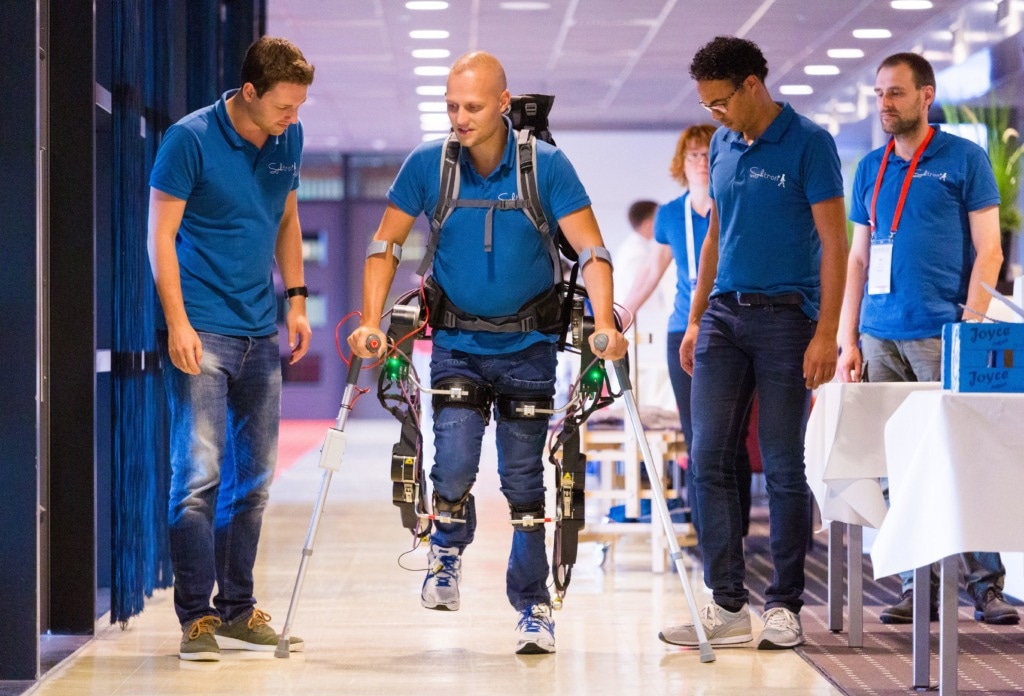
Image Credit: Gijs van Ouwerkerk
Cross-fertilization of knowledge and ideas could enrich academic debate and promote new directions for research. COST Actions play a vital catalytic role in getting scientists together throughout the spectrum of research, from basic science to social sciences, arts, and humanities, to make those crucial connections.
COST Action WearableRobots (Wearable Robots for Augmentation, Assistance, or Substitution of Human Motor Functions) stressed the integration of the various disciplines included in this growing field and also engage with an extensive range of stakeholders to assist in enhancing the technology and its possible impact on society.
Wearable robotics is considered to be a developing set of technologies that are seeking to develop personal devices, like exoskeletons, that assist or augment human functions. This unavoidably includes increased direct interaction between the robotic device and the human operator that paves the way for numerous problems like safety.
Connecting Disciplines
When the Action started there was a lot of research on robotic exoskeletons for medical application and also for supporting workers in industry. These involved separate research groups, funded from a variety of diverse sources and operating in different domains such as healthcare or industrial environments. Our aim was to bring everyone together.
Jan Veneman, Chair of the Action, Swiss company Hocoma Medical GmbH
Since wearable robots constantly interact with humans in multiple and altered situations, Human-Robot Interaction, Ergonomics, and Ethical, Legal, and Societal (ELS) issues are also components, together with early involvement of regulatory and other stakeholders, that are necessary to guarantee the ideal positive impact of such technologies for society.
As well as the technical disciplines such as mechatronics, electronics, materials etc. we wanted to involve ELS topics from the start. This meant finding and engaging with people from the social sciences that were interested in robotics and their impact.
Jan Veneman, Chair of the Action, Swiss company Hocoma Medical GmbH
Also connecting disciplines, the Action was able to link various continuing research programs to guarantee the exchange of knowledge and further reduce overlap.
These included significant projects like Eurobench, which was establishing a European benchmarking system for the performance of bipedal robots, and the COVR project concentrating on the safety of collaborative robots.
Standards
Also, Action has played a significant role in shaping the future of the wearable robotics field as a result of the publication of a range of scientific review papers covering the various aspects of wearable robots and also the involvement of members of the standardization community.
Several participants in the Action were experts on international standards development. And in our COST meetings they could discuss potential standards with the wider community and get the feedback they needed.
Jan Veneman, Chair of the Action, Swiss company Hocoma Medical GmbH
This led to the Action, collectively with Eurobench, being able to make an EU-level workshop agreement with CEN/CENELEC (the pan-European Standards organization). This produced protocols to benchmark robots that are walking over ground and barriers and allows extensive comparison of performance.
Also, the Action-funded Short-Term Scientific Missions allow scientists to test their prototypes at the same facility in Madrid by making use of the protocols.
Especially, Jan is proud of the Training Schools organized via the Action.
Jan added, “These were a key achievement for integration of different disciplines. Participants were exposed to information and experience they would not otherwise be able to normally access and made valuable connections between researchers that will continue beyond the Action.”